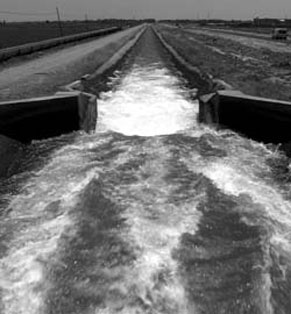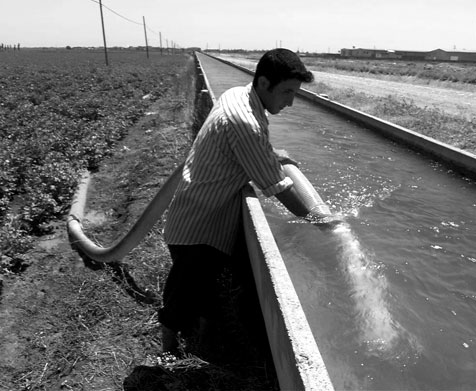Chapter 5
By Eugene F. Provenzo, Jr. and Cory A. Buxton
Virtual Water & Your Water Footprint

| Florida Sunshine State Standards Benchmark | |
| SC.A. 1.2.1 | The properties of materials (in this case, volume) can be compared and measured. |
|---|---|
| SC.B. 1.2.1 | The student knows how to trace the flow of energy in an ecosystem. |
| SC.G. 2.2.2 | The size of a population is dependent upon the available resources within its community. |
| SC.H. 1.2.1 | It is important to keep accurate records and descriptions of experiments. |
Virtual Water: How Much Water Does It Take to Produce Things?

Farmer taps into a water channel that runs hundred of gallons of water in southeast Turkey every day.
“Virtual water” refers to the amount of water it takes to grow or manufacture something. The phrases “embedded water,” “hidden water,” and “embodied water” refer to the same concept. Understanding how much water it actually takes to grow a plant or manufacture an item is essential to understanding how we can protect our fresh water resources.
Did you know that people in the United States consume about 2,500 cubic yards of water per year; that it takes just under 150 quarts of water to produce every cup of coffee we drink; that the manufacture of a small car takes roughly 400,000 quarts of water, and that building a small home requires roughly 5 million quarts of water?
Activity: Determining Your Water Footprint
Do you know how much water you use in a year? This is your “water footprint.” You can find out by visiting the following website, which has a water footprint calculator:
Water Footprint
http://www.waterfootprint.org/?page=files/home
Find out what your specific consumption is per year. If you don’t know your family’s annual income, use the figure of $48,000 for your “gross yearly income.” The calculator estimates in cubic meters. A cubic meter is slightly larger (about 39 inches) than a box one yard high, wide and deep.
Using the calculator, determine the water footprint for someone in the United States, Egypt, Fiji, Turkey, and China. Why do you think there are such large differences between some of the countries?
Have students review the following summary questions:
- If water is a limited and finite resource, should some countries be allowed to consume much more water than others?
- Are some uses of water better than others (for example, producing basic food rather than luxury goods)?
- When we consume water to make different products, are we, in fact, consuming other people’s water (Hint: If it takes water to create a pair socks that we buy from China, then we are consuming Chinese water, and the amount is therefore part of our water footprint).
All of us need to be concerned with how scarce useable water is on the Earth. Even those of us who live in places where water seems plentiful have an obligation not to waste water. In the following activities, students should become more aware of water conservation issues and how they can contribute to protecting this precious resource.
Consider the Quote
“Every human should have the idea of taking care of the environment, of nature, of water. So using too much or wasting water should have some kind of feeling or sense of concern. Some sort of responsibility and with that, a sense of discipline.” — The 14th Dalai Lama Tenzin Gyatso
Exploring One Water
Would you use water as carefully as the Indian woman does, taking a small amount to bathe her child, wash clothes, and water a tree? How do you use water on a day-to-day basis in your family?
Extension Activities
Elementary School Students
If you have a sink in your classroom, have students leave the water running full blast and ask each of them to pretend to brush their teeth—just like they do every day. Instead of running the water down the drain, collect it in gallon milk bottles. Then measure the amount of water that has been used. Have students compare this amount with how much water would be required to just wet their toothbrush and rinse (assume that at most this would take a quart of water).
Have students now estimate how much more water they use by leaving the tap running (ten times, twenty times as much per brushing). Have students calculate how much water they consume in a week by leaving the water running; how much in a year; how much in an eighty-year lifetime.
Multimedia
Have students create posters about how to save water by not letting the water run when they brush their teeth.
Middle School Students
Have students complete the following survey and then have them compile the statistics on their use of water for a year.
How much water do you use in the bathroom? Seventy-five percent of all water use takes place in the bathroom. Answer the following questions to determine how much water you use every day.
- How often do you brush your teeth each day? __________ X See Below = __________
If you turn off water while brushing, write 1 quart. If you leave the water running while brushing, write 4 gallons. - How long do you spend in the shower? __________ X See Below =__________
If you have a low-flow showerhead, write 2 gallons; If you have a standard showerhead, write 5 gallons. - How many times per day do you flush the toilet? __________ X See Below =__________
If you have a low-flush toilet, write 3 gallons. If you have a standard toilet, write 5 gallons.
Multimedia
Have students create a Power Point™ presentation or poster that explains how much water can be saved by low-flow showerheads and smaller flush toilets.
Secondary School Students
The water footprint of a nation is the amount of water needed for the consumption of goods and services of the country. In the United States, the average water footprint is 2,500 m3/cap/yr. In China, the average water footprint is 700 m3/cap/yr. Assume that fresh water is going to become an increasingly scarce resource. Now imagine that you are a scientist/policy maker trying to make the use of water more equitable. Write a position paper, one page in length, that would outline a policy for making water consumption and use more equitable. Consider the idea of special taxes, incentives, and so on.
Multimedia
Create a Power Point™ slide show that presents how much water it takes to produce specific consumer goods, such as cars, houses, as well as food, such as a half-pound hamburger or a loaf of bread.
